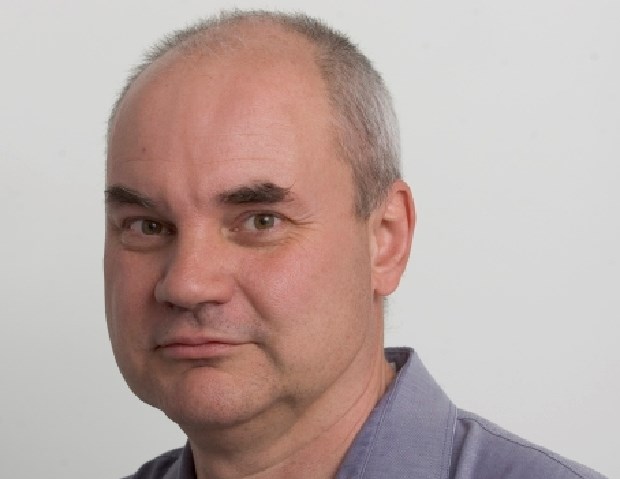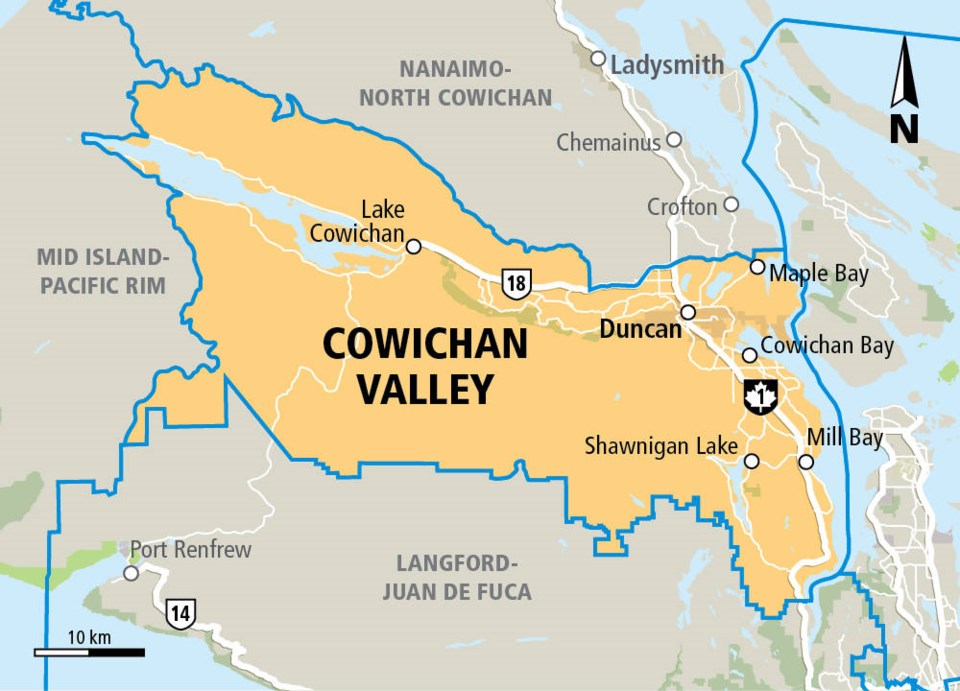 As the Oct. 24 provincial election approaches, Jack Knox is looking at Vancouver Island’s 14 ridings and some of the issues affecting them. Today: Cowichan Valley.
As the Oct. 24 provincial election approaches, Jack Knox is looking at Vancouver Island’s 14 ridings and some of the issues affecting them. Today: Cowichan Valley.
The signs along the Trans-Canada outside Duncan advertise fireworks. Presumably they refer to Halloween, not election night, though this looks like a tight race.
It wasn’t that close last time. In 2017, newcomer Sonia Furstenau bucked the rising NDP tide and won Cowichan Valley for the Greens by almost 1,900 votes.
The local New Democrats didn’t do themselves any favours in that campaign by descending into an internal squabble over who would replace retiring MLA Bill Routley on the ballot. The party’s rules say that when a male incumbent steps down, the next candidate must be a woman or member of an “equity-seeking” group — a visible minority, say, or someone with a disability — but that policy ticked off the riding association’s president so much that he stomped off and ran as an independent. He only earned a few hundred votes, but the fuss weakened the NDP in what had been a safe seat.
There’s no such division this time. The New Democrats, represented by two-term North Cowichan municipal councillor Rob Douglas, are keen to wrest the riding back. On Sunday, Premier John Horgan lent his weight to the cause by showing up — on a day on which the NDP vowed to double B.C.’s funding for protecting wild salmon — for a photo op in which he and Douglas went spearfishing with elders of the Cowichan Tribes.
This time, it’s the Greens’ internal relationships that have some scratching their heads. In May, after Furstenau went on Twitter to ponder the idea of a four-day work week, the party’s former leader, Andrew Weaver, chided her with a reply that accused her of “classic decision-based evidence-making.” It’s true that Weaver, having stepped away from party politics to deal with a family health issue, was no longer sitting in the legislature as a Green, but it was still jarring to see the former captain of the team castigate the leader-in-waiting in public.
In any case, it’s time for Furstenau to put her own stamp on the B.C. Greens. She was, as expected, elected leader in mid-September, just a week before Horgan called this election. She says her vision is for a more inclusive party that encourages more voices (ranged behind her at a Sunday news conference in Duncan were five teenagers, including 18-year-old Saanich South candidate Kate O’Connor) and an approach to public life that is more collaborative than partisan.
She hasn’t had much time for British Columbians to get to know her, though.
Furstenau’s reputation was built on her role in fighting a contaminated-soil dump at Shawnigan Lake, which might have won her accolades locally but doesn’t mean much in Vancouver or Prince George. The restrictions of a COVID-rules election haven’t helped. Other than a handful of appearances in Vancouver and a night in Whistler, she has spent the entire campaign on southern Vancouver Island.
She has tried to bridge the gap with Zoom calls and by appearing on as many radio shows as she can. She had a solid showing in the televised leaders’ debate, too. Furstenau’s fellow Green MLA Adam Olsen makes an interesting point: Back in the days when the Greens and NDP were cosy together as part of the agreement that kept the New Democrats in power, both Furstenau and Olsen were kept in the loop about what the government was doing in each of its ministries. As a result — and unlike those ministers and critics who focus on a single portfolio — the two Green MLAs feel they have done enough homework to speak confidently about any topic that might get thrown at them.
Furstenau’s message right now is that a minority government, with the restraints on power that forced co-operation brings, would be best for the province. Her opponents reply that the rare circumstances in which the three-member Green caucus found itself in 2017, wielding outsized influence in breaking a virtual tie between the Liberals and New Democrats in the 87-seat legislature, is unlikely to repeat itself. Note that many of the NDP’s roadside campaign signs in Cowichan Valley bear Horgan’s name, not candidate Douglas’s, as though to ask voters whether they want an MLA from the governing party or from the fringes.
Cowichan Valley isn’t just a two-way contest, of course, and there’s more on voters’ minds than the future of the Greens and their leader. The Liberals, who took 28 per cent of the vote in the last election, are represented by local government public servant Tanya Kaul. She has weighed in on one of the hot-button issues, calling for a time-out on a planned Island Health safe-injection site whose proposed location has drawn the wrath of residents. In September, hundreds marched in protest, arguing it was too close to Duncan schools.
Kaul has made public safety an issue, linking crime in the Duncan area to a crisis in mental health and addictions whose roots she says must be addressed.
Douglas, the municipal councillor, says he hears a lot about that issue, too, along with worries about health care, homelessness and COVID recovery. He lists the on-the-ground effects of climate change as a concern. In the end, those are the things people care about, not the struggles between and within parties.
THE CANDIDATES
• Green — Sonia Furstenau* — soniafurstenau.ca
• NDP — Rob Douglas — robdouglas.bcndp.ca
• Liberal — Tanya Kaul — bcliberals.com/team/tanya-kaul
* incumbent
RESULTS IN 2017
• Green — Sonia Furstenau 11,449 (37.24 per cent)
• NDP — Lori Lynn Iannidinardo 9,723 (31.63 per cent)
• Liberal — Steve Housser 8,502 (27.66 per cent)
• Libertarian — James Robert Anderson 302 (0.98 per cent)
• Independent — Ian Morrison 502 (1.63 per cent)
• Independent — Eden Haythornthwaite 119 (0.39 per cent)
• Independent — Samuel Lockhart 145 (0.47 per cent)
• Voter turnout: 67.58 per cent



